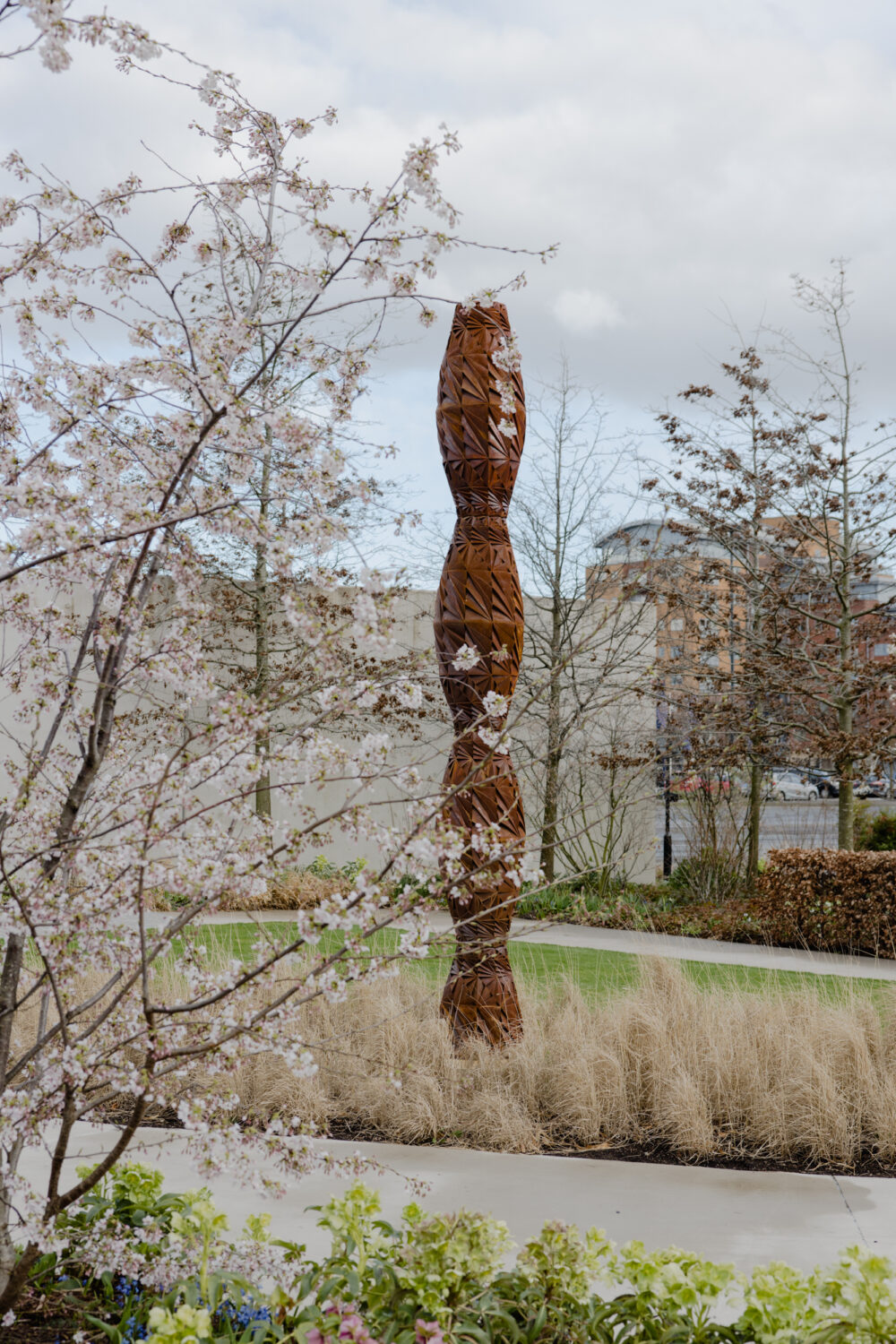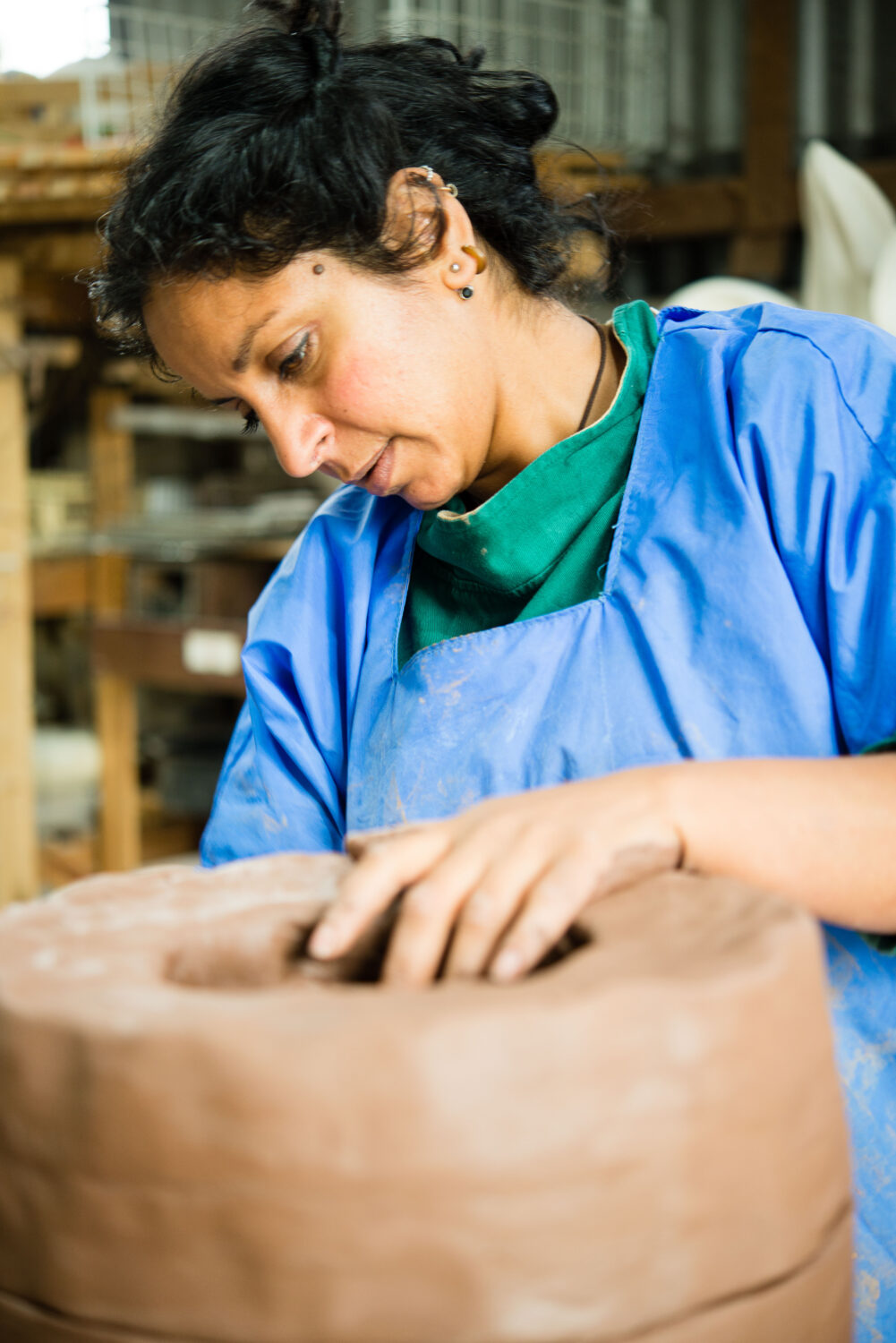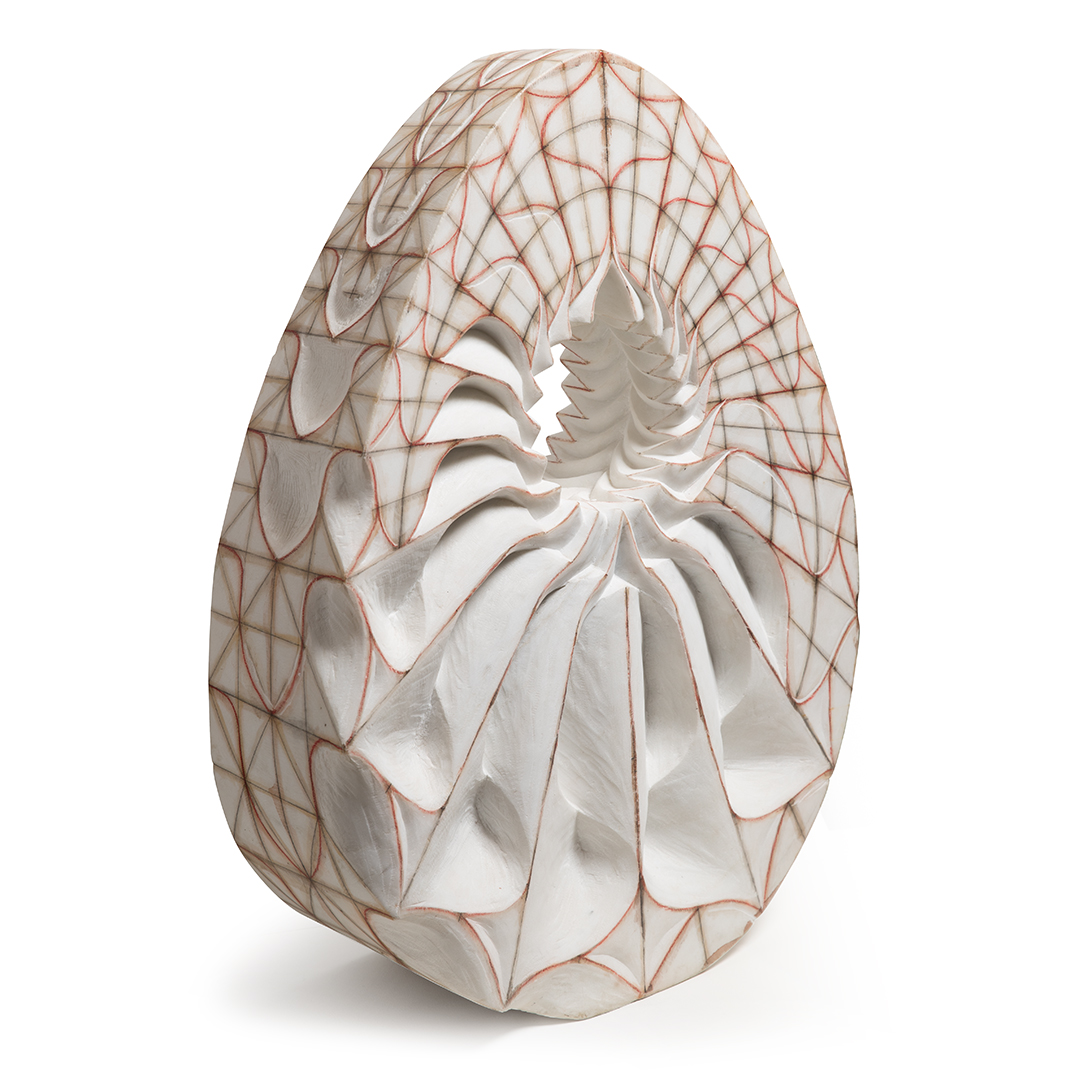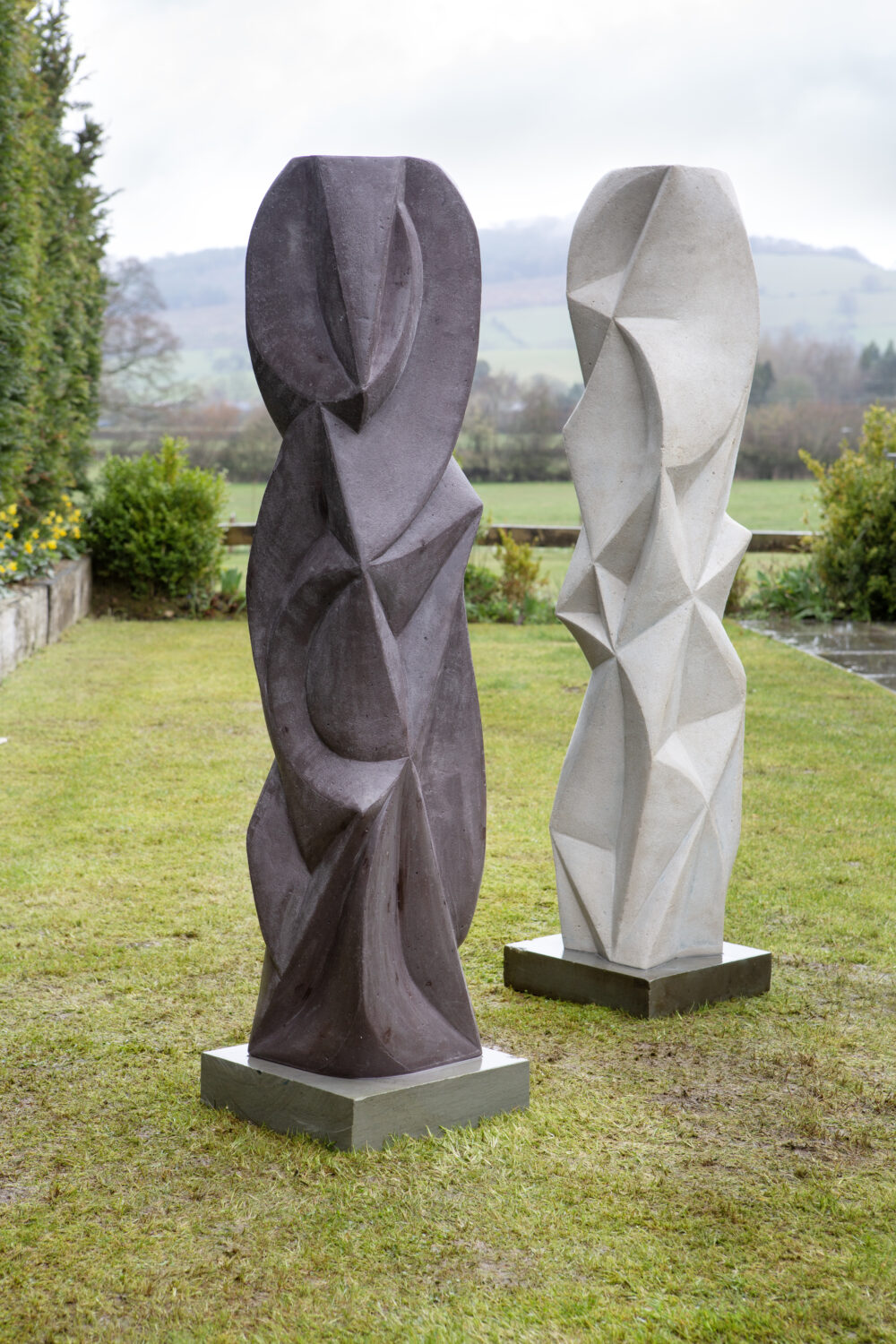Interview: Sculptor Halima Cassell On Numerology & Islamic Surface Design
By Something CuratedBorn in Pakistan and raised in North West England, sculptor Halima Cassell MBE’s varied and multicultural background, underpinned by her interests in Islamic art, design and architecture, is tangibly present in her work. Her distinctive style combines striking shapes with an extensive array of intricately carved and elaborate patterns. Blending strong geometric elements with recurring motifs and architectural principles, Cassell employs precise lines and bold angles to convey the universal language of numbers and evoke a sense of motion. Crafting each sculpture takes an impressive dedication of anywhere from 100 to 250 hours, resulting in pieces that boast both complex designs and mesmerising finesse. As a prominent figure in contemporary British studio pottery, Cassell’s work has gained wide recognition and can be found in prestigious national and international collections, including the Victoria and Albert Museum and the Hepworth Wakefield. To learn more about Cassell’s masterful practice, her diverse influences, and her latest commission, Something Curated spoke with the artist.

Something Curated: Tell us about your journey to artmaking.
Halima Cassell: For me, it’s a very personal journey in that I really have to connect to what I’m doing. Making a piece is a very time-consuming and slow process, so it has to be enjoyable to keep me stimulated and engaged. The initial thinking with the piece is that the idea has to spark something deep inside me from the beginning, for it to carry me through the long and various processes so that I can see it through from beginning to end, as my artmaking is not so spontaneous or instant as some other forms. The end result would be that I have something exciting to share with the audience through my creative journey. That sharing is what really completes the journey for me, to see how people view and interact with my art.
I don’t just make art for art’s sake, I want to make it so that people can feel what I feel and have a connection to it, which is what makes me want to continue making art all the time. It’s not something that I see as a job; making art is something that I keep doing because it is a part of me and it’s important to me how people respond and interact to the individual pieces. I think when you see good art, it is like hearing a beautiful piece of music which imprints a long-lasting impression or feeling in someone’s consciousness. Sometimes people come back to me 10 or 15 years later and comment on the impact that my work has had on them and stayed in their minds. So my art making is able to leave a feeling or memory deep inside other people, or affect them in some way, which is the great and important satisfaction for me in my artwork.

SC: I understand you were born in Kashmir and relocated to the UK as a child with your family — do you have a recollection of this move and how do you think this culturally dual perspective has impacted your artistic approach?
HC: Even though I moved from Pakistan to the UK when I was only a one year old, I have realised that we don’t recall memories or feelings until much later when they are triggered by an event, such as the first time that I returned to Pakistan in 2009 when I was 34 years old. And coming off the airplane, I had an instant connection with the earth there and the whole smell and density of the humidity was something that was very familiar to me. It was all so familiar that I was quite nervous about how I was feeling, but then the biggest shock whilst I was there was being called a foreigner from England in my birthland which echoed my experience of growing up in Manchester where I was also called a foreigner, and that’s how the idea for my project Virtues of Unity started. The installation is about belonging, togetherness and acceptance of each other, looking at the virtues that unite us all, regardless of our cultural or religious backgrounds or the superficial differences in our appearances, such as the colour and texture of our skin and hair.
My family bought me up in a traditional Muslim environment where I was surrounded by Asian jewelry, henna painting and the visual imagery that was to be found in our prayer books, as well as in the Asian TV programmes which we watched. Inspiration was also drawn from the mosque I attended where I would enjoy the shapes and patterns on the prayer mats, and the ornateness of the interior. The architecture of my hometown Manchester was a great and important source of visual inspiration through the rich, ornate and heavily molded architecture. All these influences growing up have played a part, and greatly impacted on, my creative journey, my inspiration and thinking.

SC: Could you expand on your interest in Islamic architecture and North African design?
HC: In my degree I was doing a research project at university designing some tableware – I chose North African design as I fell in love with the idea of tessellation. I found while studying some North African complex designs on surface textiles and jewelry, that when broken down they are made out of very simple modules which when repeated and rotated create a complex design. I realised that once you have deconstructed those geometrical designs down, one has very simple shapes, which with all the beautiful and complex elaborate designs create these fabulous stylistic patterns. And what I loved about Islamic influence was the design on the heavily carved and ornate buildings for which the inspiration was drawn from nature. Again, there’s an element of tessellation, repeat patterns creating the complex surface designs which have been precisely mapped onto the convex and concave structures of this architecture. In my early work, you can see the influence of both North African and Islamic surface design in the kind of early forms and carvings that I did. Then as my work developed, the complexity within the forms and shapes became more intricate in my designs and thinking process with an even deeper connection to nature and my surroundings.
SC: What first attracted you to ceramics as a medium?
HC: One of my school teachers, John Costello, was a very good art teacher and was the one that first introduced me to ceramics. I’ve had some great teachers in my time during different aspects of my education, but John is one of the ones who really sparked that creativity in me and the ambition to discover and explore. One of the main subjects he taught at my secondary school was 3D and sculpture, and so as a teenager I fell in love with the different processes of ceramics, hand building with coils and slabs and modeling with clay which John taught me. We did work with other materials such as making sculptures with cardboard and wire, but it was the clay that I was most fascinated with, all of which became important aspects of my career. John also inspired me as a child that you could actually make a living out of art because he was selling his artwork, which then opened me up to the possibility that I could actually do something I love and make a living out of it.

SC: Are you able to tell us about your new commission, Gathering? What is the thinking behind the sculpture?
HC: Gathering is a hand-carved concrete installation, with each of the five pieces representing a figure. It is both a group coming together and a meeting place. The number five has a very spiritual and personal significance for me, I was born on the fifth day of the month and it is a number that is frequently recurring in my life and also represents my family of five, in which I include the child I lost. The number five carries deep meaning within the sciences and religions, and in numerology it represents a desire to explore, which may encourage a contemplation of new possibilities to the viewer. The forms are meant to represent figures which are in conversation, in a gathering or a coming together. Even though I don’t like to call it COVID art, that whole coming together or not being able to come together was very significant in different ways for individuals and families. I wanted to create an abstract installation of figures that were in conversation together, which work as a group.
Concrete is a relatively new material for me and I first saw it in a beautiful light through a presentation from the David Chipperfield Practice explaining their use of it in the design and concepts behind the construction of the new Hepworth Wakefield building that had recently been commissioned. It was after this introduction and a few years later through a research project that I looked at exploring it as a potential material for my work. I then created my own bespoke way of working with this industrial material, and so it has now become an important part of my creative practice. I have to be more immediate with it compared to my usual design process because one only has a few days to carve whilst it is green before you have to use the grinders and chisels, followed by the process of hand finishing with sandpaper. I love my response to concrete as I am a lot more spontaneous when I’m thinking about the design. As a material it has something special that allows me to work and think differently.
Halima Cassell is one of five artists taking part in Wakefield Sculpture Trail, throughout the city centre, presented by Wakefield Council.
Feature image: Halima Cassell, Fan Construction, 2023. On display in The Hepworth Wakefield Garden. Photograph: Anya Raczka